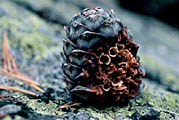 |
|
|
|
|
|
| Regeneration mechanisms Most subalpine forest trees are able to propagate by more than one mechanism. Regeneration by seeds, the most frequent regeneration mechanism of subalpine trees, involves genetic recombinations and produces genetically unique individuals. Sprouting from stumps or stolons produces new individuals without genetic recombination. The potential to propagate by sprouting or layering is rarer among subalpine trees. |
The Populus tremuloides (Quaking aspen), however, regularly propagates by root sprouts. Genetic recombinations probably occur with less frequency in species with asexual regeneration mechanisms as in P. tremuloides. Propagation in the near vicinity of a mother tree is very fast. However, the population has the same genetic structure, forcing the risk of inbreeding depression. |
|
| Successful seed dispersal
and germinant establishment depends on the reproductive traits of a species,
on probabilities of seed transport by a vector, and on appropriate seed
bed conditions. Most important aspects are: |
1 - Population of
vegetatively propagated Populus tremuloides ramets of different age Photo: V. Stöckli |
Seed set The number of seeds produced by a tree varies considerably from year to year and species to species. Some species produce only a few seeds, but provide each seed with a large reserve of nutrients (fruits, nuts). The reserves allow temporary independence of an appropriate substratum, increasing the probability of survival at least for some years after a season of comparitively high germination. Other species produce many small seeds containing little stored food reserves. In contrast to seeds with large nutrient reserves, the probability of survival of any single seed is small. But, the large number of seeds ensures that at least some individuals will reach suitable sites, germinate and grow. In all cases the ratio of successful establishment of trees to the number of seeds produced is low. The phenomenon of masting or mast seeding is the periodic, synchronous production of a large number of seeds. Masting appears to be controlled by several factors including climate and pollination efficiency. The reason for irregular seed production are not known. However, irregular seed production seems to increase the number of seeds dispersed and may increase cross-pollination and reduce the chance of seed predation. |
Pre-dispersal predation of seeds The pre-dispersal predation of seeds is significant. A large number of insect species, birds and mammals are known to live on developing seeds of subalpine forest trees. For Picea abies, a number of many insect species are known to feed on seeds in the cones. |
|
|
Dispersal of seeds |
2 - The bird Loxia curvirostra, the cross-bill, lives on the seeds of Picea abies. (80K) |
| The dispersal of seeds is either effected by the wind (anemochor) or by animals (zoochor). Unlike in the tropics, where most tree species rely on frugivorous animals for the dispersal of their seeds, the majority of seeds of subalpine trees are anemochor. The seeds of the conifers Picea, Abies, and Larix species are typically winged. Among the genus Pinus, both anemochor (e.g. Pinus silvestris, Pinus uncinata) and zoochor (Pinus cembra) are known. |
| The winged
seeds are transported long distances from the parent tree. At a 100m distance
from the forest border Picea abies the amount of seeds found was between
10 and 30 % of seeds found in the closed forest. At a distance of 400m,
an amount of 5 % seeds was still found (Laessig
et al. 1995). The seeds of Picea abies in subalpine areas propagate
between October and May.
The nuts of Pinus cembra (Swiss stone pine) are mainly dispersed by the Nucifraga caryocatactes (nuthatch). The bird selects sites for scatter hoarding preferably near significant marks in the landscape such as rocky outcrops. |
 |
| 3 - Conifer seeds on the snow
surface in March Photo: V. Stöckli (80K) |
| Scatter hoarding removes nuts from other sources of nut predation, moves nuts away from source trees where density-dependent mortality is high, and buries nuts in the soil reducing rates of predation and maintaining nut viability. The large nutrient reserves of nuts also permit seedlings to establish a large photosynthetic surface or extensive root system, making them especially competitive in low-light environments and semi-arid environments. |
|
Favourable microsites for germination The seedbed substratum must offer sufficient water, nutrients and a firm anchorage for the seedling. Exposed mineral soil or such non-ground substratum as fallen "nurse" logs or buttresses are preferred substrata. Exposed mineral soil allowing direct seed-soil contact offers nutrients in a ready to use form. In addition, unlike on an undisturbed forest floor, competition with forbs and grasses is absent. The decaying wood of "nurse" logs offers a microsite of constant humidity, warmer temperatures and earlier snow melt than its surrounding. The most important post-establishment causes of seedling failure are
|
|
Bazzaz F A, The physiological
ecology of plant succession, 1979, Ann. Rev. Ecol. Syst. 10:351-371. |
29 August 2011 |
||
| |
||




